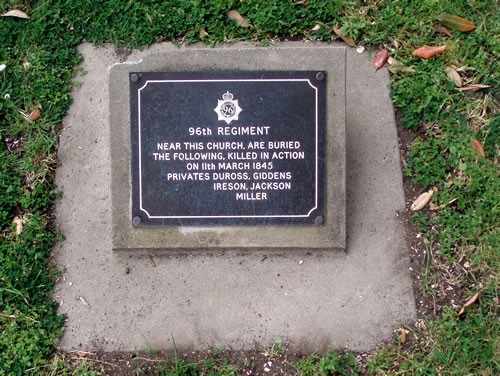
The 96th (Manchester) Regiment – ‘The Bendovers’ – first sent a detachment to New Zealand in 1843. During the New Zealand Wars, most of the 2nd Battalion served here between 1845 and 1847 under the command of Lieutenant Colonel William Hulme. On 11 March 1845 the 96th Regiment played a significant role in the defence of the Bay of Islands township of Russell, then known as Kororāreka.
Just before dawn on the morning of 11 March, anti-government Māori made a coordinated three-pronged attack on Kororāreka. One party of 150 men led by Ngāpuhi chief Hōne Heke surprised 20 men of the 96th Regiment who, under Ensign John Campbell, were garrisoning the flagstaff blockhouse on Maiki Hill. Sixteen of these men were outside the blockhouse at the time. Heke seized the blockhouse, killing its four occupants, and felled the flagstaff for a fourth (and final) time.
Another party of the 96th, under Lieutenant Edward Barclay, provided support to men from HMS Hazard who were engaged in a long and desperate struggle with some 200 men led by Ngati Hine chief Te Ruki Kawiti.
The British troops were forced to retreat. In the afternoon, with the remaining civilians safely evacuated to ships waiting in the bay, Hazard bombarded Kororāreka. The township was then looted and burned by both British and Maori. Ten British troops had been killed, and another two men died from injuries they received when a magazine exploded at Polack’s Stockade. About 23 men were wounded. It is thought that about 13 Māori were killed and 28 wounded.
Rather than acknowledge a Māori victory, the British attributed their defeat, in large part, to the incompetence of their commanding officers. Major Cyprian Bridge could not conceive ‘how any man with a blockhouse and guard in so commanding a position [Campbell] could have allowed himself to be surprised and let it be taken’. Barclay was one of three officers severely criticised for the ‘premature’ decision to evacuate the town.
Barclay and Campbell were court-martialled in Auckland in August 1845. Barclay was found not guilty on three charges, while Campbell was found guilty on one charge of ‘highly unofficer-like conduct’.
Across the bay from Russell, St Paul’s Church stands on the waterfront in the resort town of Paihia. This is New Zealand’s first consecrated burial ground, having been accorded that status in 1839. It is also known as the Williams Memorial Church as a large memorial to Archdeacon Henry Williams stands in the churchyard. The cemetery contains the marked and unmarked graves of early Māori Christians, European missionaries and settlers and, it is thought, troops who died during the New Zealand Wars.
This small bronze plaque is situated in the grounds of St Paul’s. It records the names of five privates from the 96th Regiment who are thought to have died defending Kororāreka on 11 March 1845. However, one of the five men, Private James Duross, died in Auckland on 4 April 1845 and it is unlikely that he was buried in Paihia.
The exact location of the grave site is unknown. According the vicar, writing on 7 May 1995, ‘There is no plan for St. Paul’s churchyard. Oral tradition has it that archival material on its way to Auckland was lost when the ship sank, and that this loss included the plan.’
Russell Museum holds a photograph of this plaque in its collections. The caption reads: ‘Military plaque in Paihia churchyard unveiled 11.3.1981. Killed in defence of Kororareka flagstaff 1845.’ It is not known who was responsible for the installation of the plaque in 1981.
Inscription
96th Regiment / Near this church are buried / the following, killed in action / on 11th March 1845 / Privates Duross, Giddens / Ireson, Jackson / Miller
Further information
- ‘Courts martial’, New Zealander, 11 October 1845
- ‘Narrative of events at the Bay of Islands’, New Zealander, 19 November 1845
- James Belich, ‘A limited war’, in The New Zealand Wars and the Victorian interpretation of racial conflict, Penguin, Auckland, 1998, pp. 29–44
- James Cowan, ‘The fall of Kororareka’, in The New Zealand Wars: a history of the Maori campaigns and the pioneering period: volume I: 1845–1864, R.E. Owen, Wellington, 1955, pp. 25–33
- Nigel Prickett, ‘The Northern War 1845–46’, in Landscapes of conflict: a field guide to the New Zealand Wars, Random House, Auckland, 2002, pp. 38–47
- Chris Pugsley, ‘Walking Heke’s War: The Sack of Kororareka, 11 March 1845’, New Zealand Defence Quarterly, no. 1 (Winter 1993), pp. 12–17
- ‘Regiments that have been amalgamated’, A.H. McLintock (ed.), An Encyclopaedia of New Zealand, 1966, published online by Te Ara – the Encyclopedia of New Zealand, updated 22-Apr-09

Community contributions